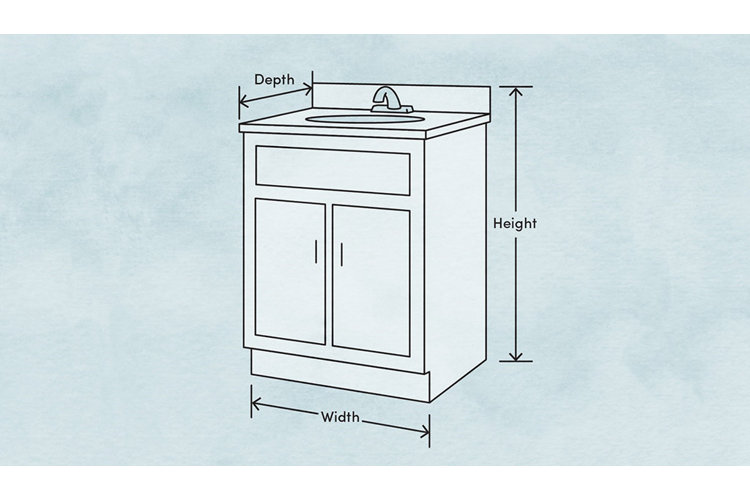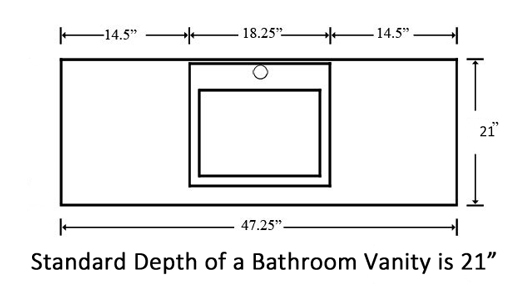The standard bathroom vanity width typically ranges from 24 to 72 inches. Most commonly, vanities are 30, 36, or 48 inches wide.
Choosing the right bathroom vanity width is crucial for both functionality and aesthetics. A well-sized vanity provides ample storage while complementing the overall design of your bathroom. Smaller spaces benefit from compact vanities, while larger bathrooms can accommodate wider options for more storage and counter space.
It’s essential to measure your available area accurately and consider plumbing locations before making a purchase. Remember to factor in additional space for ease of movement. By selecting the appropriate width, you can enhance the efficiency and visual appeal of your bathroom, making it a more enjoyable space.
Introduction To Bathroom Vanity Width
The width of a bathroom vanity is vital for design and function. Choosing the right size enhances usability. It also affects the overall look of your bathroom. Knowing standard widths helps in making informed choices.
Why Size Matters
Size influences several aspects of your bathroom:
- Space Efficiency: A correctly sized vanity maximizes space.
- Storage: Wider vanities provide more storage options.
- Style: The right width complements your bathroom’s design.
- Accessibility: Ensures easy movement in the bathroom.
Small bathrooms need compact vanities. Larger bathrooms can accommodate wider options. Think about your needs before selecting a size.
Common Vanity Widths
Bathroom vanities come in various standard widths. Here’s a quick overview:
| Width (inches) | Common Use |
|---|---|
| 24 | Small bathrooms or powder rooms |
| 30 | Compact spaces |
| 36 | Standard size for most bathrooms |
| 48 | Shared bathrooms |
| 60 | Master bathrooms |
| 72 | Luxury or spacious layouts |
Consider these widths for your bathroom project. The right size can transform functionality and style.
Credit: vevano.com
Measuring Your Space
Measuring your bathroom space is essential. It helps you choose the right vanity size. A standard bathroom vanity width usually ranges from 24 to 72 inches. Knowing your space helps avoid costly mistakes.
Tools Needed
- Measuring tape: A reliable tool for accurate measurements.
- Level: Ensures the vanity will sit straight.
- Pencil: For marking measurements on the wall or floor.
- Notepad: To jot down your measurements.
- Calculator: For quick calculations.
Step-by-step Guide
- Clear the Area: Remove any items around the space.
- Measure Width: Measure the width of the space in inches.
- Measure Depth: Measure the depth from the wall to the edge.
- Check Height: Measure from the floor to the ceiling.
- Note Electrical Outlets: Make a note of any outlets nearby.
- Identify Plumbing: Mark the location of pipes and drains.
- Record Measurements: Write down all the numbers clearly.
These steps ensure you find the perfect vanity for your space.
Standard Vanity Widths
Choosing the right width for your bathroom vanity is crucial. It affects both style and functionality. Vanities come in various sizes. Understanding standard widths helps you make an informed choice.
Single Sink Vanities
Single sink vanities are popular in smaller bathrooms. They provide enough space for essential items while saving room. Here are some common widths:
| Width (inches) | Common Features |
|---|---|
| 24 | Ideal for tight spaces |
| 30 | Offers extra storage |
| 36 | Great for larger single sinks |
These sizes accommodate various styles. Choose one based on your space and needs.
Double Sink Vanities
Double sink vanities are perfect for shared bathrooms. They allow two people to use the space at once. Here are standard widths:
- 48 inches: Great for compact spaces.
- 60 inches: Offers ample counter space.
- 72 inches: Provides the most storage options.
These widths enhance functionality. Consider your bathroom size before choosing.
Custom Vs. Pre-made Vanities
Choosing between custom and pre-made vanities can be tough. Both options have unique features. Understanding their pros and cons helps make the right decision. Let’s explore both choices.
Pros And Cons
| Type | Pros | Cons |
|---|---|---|
| Custom Vanities |
|
|
| Pre-made Vanities |
|
|
What Fits Your Bathroom
Consider your bathroom size before deciding. Measure your space accurately. This will help you choose the right vanity.
For small bathrooms:
- Pre-made vanities often work best.
- Look for compact designs.
- Choose lighter colors to create an illusion of space.
For large bathrooms:
- Custom vanities can maximize functionality.
- Choose unique designs that reflect your style.
Choose wisely. The right vanity enhances your bathroom’s look and feel.
Maximizing Small Bathroom Spaces
Small bathrooms can feel cramped. Effective design can make them functional and stylish. Choosing the right fixtures is key to maximizing space. A well-selected bathroom vanity can transform your area.
Innovative Solutions
Creative ideas can help you maximize your small bathroom. Here are some innovative solutions:
- Wall-mounted vanities save floor space.
- Corner vanities utilize unused corners efficiently.
- Multi-functional furniture offers storage and surface space.
- Open shelving keeps essentials accessible.
Choosing The Right Vanity
Selecting the right vanity is crucial for small bathrooms. Consider the following points:
- Width: Standard widths range from 24 to 60 inches.
- Height: Standard height is typically 30 to 36 inches.
- Depth: Shallow vanities are ideal for tight spaces.
- Style: Choose a design that complements your decor.
Evaluate your needs before making a choice. The right vanity maximizes storage and enhances style. Measure your space carefully to ensure a proper fit.
| Vanity Type | Benefits |
|---|---|
| Wall-mounted | Creates an illusion of space. |
| Corner | Utilizes otherwise wasted corners. |
| Pedestal | Offers a sleek, minimal look. |
| Floating | Gives a modern, airy feel. |

Credit: kitchencabinetkings.com
Installation Tips And Tricks
Installing a standard bathroom vanity can be simple with the right guidance. Follow these tips to ensure a smooth installation process. Focus on preparation, mounting, and plumbing for success.
Preparation
Proper preparation makes installation easier. Here are the steps:
- Measure the space for the vanity.
- Check for level floors and walls.
- Gather necessary tools:
| Tools | Purpose |
|---|---|
| Level | Ensure the vanity is straight. |
| Stud finder | Locate wall studs for support. |
| Drill | Secure the vanity to the wall. |
| Wrench | Connect plumbing fixtures. |
Make sure to remove any old fixtures. Clean the area to avoid dust and debris.
Mounting And Plumbing
Mounting the vanity correctly is crucial. Follow these steps:
- Position the vanity against the wall.
- Use a level to check alignment.
- Mark the wall where brackets will go.
- Drill holes and insert anchors.
- Attach the vanity securely.
Next, focus on plumbing:
- Shut off the water supply.
- Connect the water lines to the faucet.
- Attach the drain assembly.
- Turn the water back on and check for leaks.
Test all fixtures to ensure they work properly. Enjoy your newly installed vanity!
Style And Functionality
Choosing the right bathroom vanity width balances style and functionality. A well-chosen vanity enhances your bathroom’s look. It also provides essential storage and usability.
Matching Your Decor
The style of your bathroom vanity should match your overall decor. Consider these factors:
- Color: Choose colors that complement your walls.
- Material: Wood, metal, or glass can set the tone.
- Design: Modern, rustic, or traditional styles create different vibes.
A narrow vanity suits small spaces, while a wide vanity fits larger areas. Ensure the style aligns with your bathroom theme. This creates a cohesive look.
Storage Solutions
A functional vanity provides ample storage. Consider these storage options:
| Storage Type | Description |
|---|---|
| Drawers | Ideal for storing toiletries and makeup. |
| Cabinets | Perfect for towels and cleaning supplies. |
| Shelves | Great for displaying decor and extra items. |
Consider a vanity with multi-functional storage. This maximizes space and keeps your bathroom organized.
Final Considerations
Choosing the right bathroom vanity is important. Consider factors like size, style, and budget. This section will guide you through key aspects to finalize your decision.
Budgeting
Setting a budget helps narrow down your options. A clear budget ensures you make smart choices. Here are some key points to consider:
- Standard vanities range from $200 to $2,000.
- Custom vanities can cost even more.
- Plan for installation costs, which vary by location.
- Consider maintenance and repair expenses over time.
Long-term Satisfaction
Think about your long-term happiness with the vanity. A good choice should last years. Here are tips for ensuring satisfaction:
- Choose durable materials like hardwood or solid surface.
- Select a style that matches your home decor.
- Ensure enough storage for your needs.
- Consider ease of cleaning and upkeep.
Assess the warranty offered. A longer warranty often indicates quality. Aim for a vanity that complements your lifestyle.

Credit: www.wayfair.com
Frequently Asked Questions
Is 24 Too Deep For A Vanity?
A 24-inch depth for a vanity is generally considered deep. It offers ample space for storage and use but may overwhelm smaller bathrooms. Ensure the depth fits your bathroom layout and personal preferences for comfort and functionality. Always measure your space before making a decision.
How Wide Should A Single Vanity Be?
A single vanity typically ranges from 24 to 60 inches in width. For small bathrooms, a 30-inch vanity works well. Larger spaces can accommodate vanities up to 48 inches or more. Always consider your bathroom layout and storage needs when choosing the size.
How Wide Is A Double Bathroom Vanity?
A double bathroom vanity typically ranges from 60 to 72 inches wide. This size provides ample space for two sinks and extra countertop area. Ensure to measure your bathroom for a perfect fit. Choosing the right width enhances both functionality and style in your space.
How Much Space Should Be On Each Side Of Bathroom Vanity?
Aim for at least 2 to 4 inches of space on each side of the bathroom vanity. This gap allows for easy access and cleaning. For larger vanities, consider 6 inches for better visual balance. Proper spacing enhances functionality and aesthetics in your bathroom design.
Conclusion
Choosing the right bathroom vanity width is crucial for both functionality and aesthetics. It impacts your space and overall design. Consider your bathroom size and storage needs carefully. A well-selected vanity enhances convenience and style. Make informed decisions to create a bathroom you’ll love for years to come.
Happy decorating!
